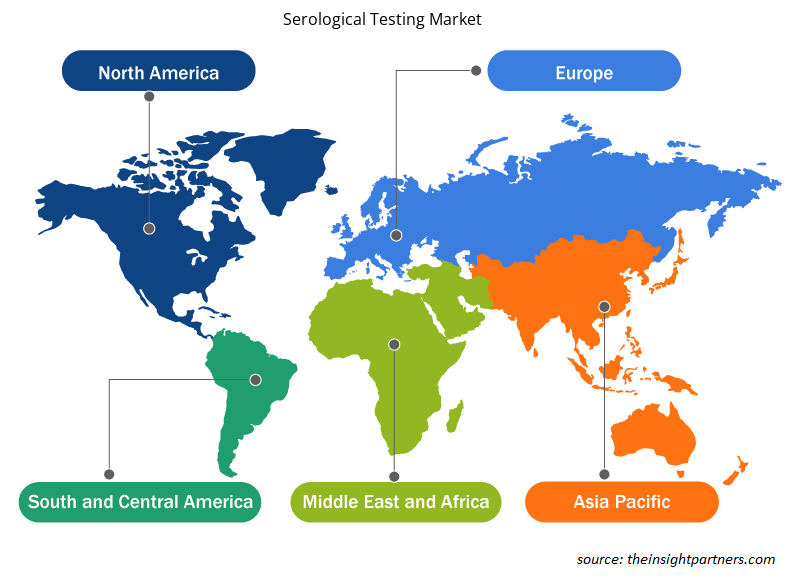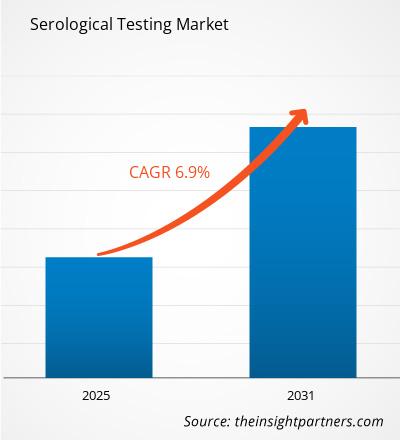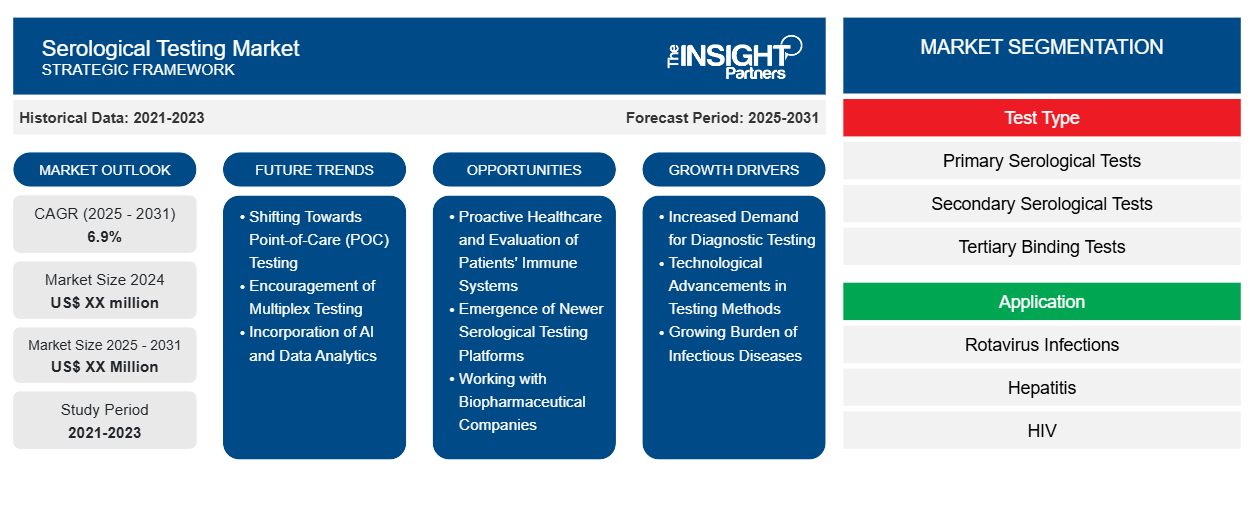Es wird erwartet, dass der Markt für serologische Tests von 2023 bis 2031 eine durchschnittliche jährliche Wachstumsrate (CAGR) von 6,9 % verzeichnet, wobei die Marktgröße von XX Millionen US-Dollar im Jahr 2023 auf XX Millionen US-Dollar im Jahr 2031 wächst.
Der Bericht ist nach Testtyp segmentiert (Primäre serologische Tests, Sekundäre serologische Tests, Tertiäre Bindungstests). Der Bericht präsentiert außerdem Analysen basierend auf der Anwendung (Rotavirusinfektionen, Hepatitis, HIV, Endotoxin, Therapeutische Arzneimittelüberwachung, Andere Infektionskrankheiten). Der Bericht ist nach Endbenutzern segmentiert (Krankenhäuser, Diagnoselabore, Blutbanken, akademische und Forschungsinstitute, Andere). Die globale Analyse ist weiter auf regionaler Ebene und nach wichtigen Ländern aufgeschlüsselt. Der Bericht bietet den Wert in USD für die oben genannte Analyse und Segmente.
Zweck des Berichts
Der Bericht „Serological Testing Market“ von The Insight Partners soll die aktuelle Situation und das zukünftige Wachstum sowie die wichtigsten treibenden Faktoren, Herausforderungen und Chancen beschreiben. Dies wird verschiedenen Geschäftspartnern Einblicke geben, wie zum Beispiel:
- Technologieanbieter/-hersteller: Um die sich entwickelnde Marktdynamik zu verstehen und die potenziellen Wachstumschancen zu kennen, damit sie fundierte strategische Entscheidungen treffen können.
- Investoren: Durchführung einer umfassenden Trendanalyse hinsichtlich der Marktwachstumsrate, der finanziellen Marktprognosen und der Chancen entlang der Wertschöpfungskette.
- Regulierungsbehörden: Sie regulieren Richtlinien und polizeiliche Maßnahmen auf dem Markt mit dem Ziel, Missbrauch zu minimieren, das Vertrauen der Anleger zu bewahren und die Integrität und Stabilität des Marktes aufrechtzuerhalten.
Serologische Tests Marktsegmentierung
Testtyp
- Primäre serologische Tests
- Sekundäre serologische Tests
- Tertiäre Bindungstests
Anwendung
- Rotavirus-Infektionen
- Hepatitis
- HIV
- Endotoxin
- Therapeutisches Arzneimittelmonitoring
- Andere Infektionskrankheiten
Endbenutzer
- Krankenhäuser
- Diagnostische Labore
- Blutbanken
- Akademische und Forschungsinstitute
- Sonstiges
Geographie
- Nordamerika
- Europa
- Asien-Pazifik
- Süd- und Mittelamerika
- Naher Osten und Afrika
Geographie
- Nordamerika
- Europa
- Asien-Pazifik
- Süd- und Mittelamerika
- Naher Osten und Afrika
Passen Sie diesen Bericht Ihren Anforderungen an
Sie erhalten kostenlos individuelle Anpassungen an jedem Bericht, einschließlich Teilen dieses Berichts oder einer Analyse auf Länderebene, eines Excel-Datenpakets sowie tolle Angebote und Rabatte für Start-ups und Universitäten.
-
Holen Sie sich die wichtigsten Markttrends aus diesem Bericht.Dieses KOSTENLOSE Beispiel umfasst eine Datenanalyse von Markttrends bis hin zu Schätzungen und Prognosen.
Wachstumstreiber auf dem Markt für serologische Tests
- Erhöhte Nachfrage nach diagnostischen Tests: Der Fokus auf die Diagnostik hat weltweit zugenommen, insbesondere aufgrund von Covid-19, was den Bedarf an serologischen Tests erhöht. Serologische Tests helfen beim Nachweis von Antikörpern im Blut und helfen bei der Beurteilung einer früheren Infektion, der Messung der Immunreaktion und der Verfolgung der Entwicklung der Pathologie. Diese Tests werden routinemäßig eingesetzt, um die Immunreaktion nach einer Impfung oder Infektion zu bewerten und spielen eine wichtige Rolle nicht nur im Kampf gegen infektiöse Vergrößerungen wie SARS-CoV-2, sondern auch bei anderen wie dem humanen Immundefizienzvirus (HIV), Hepatitis und Lyme-Borreliose. Aufgrund des proaktiven Gesundheitsmanagements und der Überwachung von Krankheiten liegt weiterhin ein globaler Schwerpunkt auf dem Marktwachstum.
- Technologische Fortschritte bei Testmethoden: Die Verbesserungen neuer Testgeräte verbessern die herkömmlichen serologischen Tests in Bezug auf Sensitivität, Spezifität und Geschwindigkeit der Tests erheblich. Die Innovation vollautomatischer Testsysteme und Schnelltestsysteme hat die Tests beschleunigt, indem die Zeit bis zum Erhalt der Ergebnisse verkürzt wurde. Außerdem hat sich die Gesamtqualität serologischer Tests aufgrund der höheren Genauigkeit der eingeführten Tests verbessert. Auch pragmatische Ansätze wie Point-of-Care-Tests und digitale Diagnostik kommen auf den Markt und sorgen für einen schnellen Ergebnisdurchsatz sowohl innerhalb als auch außerhalb klinischer Einrichtungen, wodurch der Markt noch weiter geöffnet wird.
- Wachsende Belastung durch Infektionskrankheiten: Die Zunahme der globalen Belastung durch Infektionskrankheiten zusammen mit der wachsenden Belastung durch chronische Krankheiten hat den Bedarf an besseren medizinischen Diagnosen, einschließlich serologischer Tests, geweckt. Globale Bedrohungen wie COVID-19, HIV-Infektionen, Malaria, Hepatitis usw. sind große Probleme der öffentlichen Gesundheit, die im Hinblick auf eine aktive Diagnose und Überwachung des Immunitätsniveaus Aufmerksamkeit erfordern. Diese Gruppe von Tests trägt auch dazu bei, das Ausmaß des Ausbruchs mehrerer in der Bevölkerung auftretender Krankheiten weiter einzudämmen und gezielt auf bestimmte Risikogebiete oder Bevölkerungsgruppen zu reagieren.
Zukünftige Trends auf dem Markt für serologische Tests
- Umstellung auf Point-of-Care-Tests (POC): Der Wunsch nach tragbaren, einfach zu bedienenden Geräten für serologische Tests erfreut sich immer größerer Beliebtheit, da ein solcher Ansatz schneller Ergebnisse ohne Laboranalyse liefert. Dank Point-of-Care-Tests können medizinische Fachkräfte schnellere klinische Entscheidungen treffen, insbesondere in kritischen Situationen in abgelegenen Gebieten oder weniger entwickelten Ländern. Dies ist insbesondere bei Infektionskrankheiten nützlich, bei denen eine schnelle Diagnose die Art und Weise verändert, wie das Patientenergebnis erreicht wird. Darüber hinaus werden die Tests von No And Diagnost Ikor immer ausgefeilter, da sich das Design der Testkits und mobilen Diagnoseplattformen verbessert.
- Förderung von Multiplex-Tests: Immer mehr serologische Multiplex-Tests sind verfügbar und ermöglichen den gleichzeitigen Nachweis mehrerer Krankheitserreger oder Antikörper in einer Probe, ohne dass ein separater Test erforderlich ist. Diese Änderung ermöglicht es, mehr Testkosten zu sparen und die Tests effektiver zu gestalten, da nicht mehr mehrere Tests durchgeführt werden müssen. Systeme, die diese Technologien beinhalten, sind insbesondere dann von Vorteil, wenn mehrere Infektionen gleichzeitig ausgeschlossen oder bestätigt werden müssen. Sie sind auch für Patienten und Gesundheitseinrichtungen von Vorteil, da mit einem einzigen Test mehrere Krankheiten diagnostiziert werden können.
- Einbeziehung von KI und Datenanalyse: Ein in dieser Praxis zu beobachtender Aufwärtstrend ist die Anwendung von KI und Datenanalyse in der serologischen Diagnose, die zudem die Präzision und Zeiteffizienz der Diagnose erhöht. Das Krankheitsmanagement auf Bevölkerungsgesundheitsebene wird durch den Einsatz von KI-Tools verbessert, um eine große Menge an Testergebnissen zu sortieren, Muster zu erkennen und Krankheitsprognosen zu erstellen. Darüber hinaus unterstützen KI-Systeme von Test Management Agility die Verwaltung des Testprozesses und reduzieren Risiken, die mit den Eingaben der Personen und den für die Untersuchung verwendeten Einrichtungen verbunden sind. Die Datenanalyse ermöglicht es, solche Aktivitäten auf Bevölkerungsebene genauer und präziser zu überwachen, was wichtig ist, da Krankheitsmuster und Schwankungen der Immunität innerhalb einer bestimmten Bevölkerung durch mehr immunisierte oder geschützte Personen betroffen sind.
Marktchancen für serologische Tests
- Proaktive Gesundheitsfürsorge und Bewertung des Immunsystems von Patienten: Der Markt für serologische Tests wird durch die Einführung personalisierter Medizin und Immunitätsüberwachung positiv belebt. Während die Patiententrennung nach genauen Behandlungskategorien in vielen Gesundheitssystemen zur Norm wird, wird die serologische Bewertung für die Profilierung der mutmaßlichen Immunreaktion bei den meisten Patiententypen von zentraler Bedeutung sein. Dies ist insbesondere bei Impfstoffen relevant, bei denen ein Antikörpertest durchgeführt werden kann, um festzustellen, ob eine Person eine Auffrischungsimpfung oder eine Dosis benötigt oder vollständig immunisiert ist. Darüber hinaus wird die aktive Überwachung des Immunsystems gegen bestimmte Krankheitserreger bei der Behandlung von Krankheiten wie chronischen Krankheiten und Krebs sowie Autoimmunerkrankungen sehr praktisch werden.
- Entwicklung neuer serologischer Testplattformen: Es gibt bereits eine solide Grundlage für die Entwicklung neuartiger serologischer Testplattformen, die schneller, billiger und genauer sein können. Dazu gehören Tests, die in isolierten oder ländlichen Gebieten und unter ressourcenarmen Bedingungen durchgeführt werden können. Fortschritte bei der Entwicklung des Tests werden tragbare Lösungen, intelligente und molekulare Diagnostik sowie Biosensoren der nächsten Generation umfassen. Neue Plattformen werden nicht nur für medizinische Fachkräfte relevant sein, sondern auch für den aufstrebenden Sektor der Privatverbraucher, der zunehmend schnellere und einfachere Diagnostik benötigt.
- Zusammenarbeit mit biopharmazeutischen Unternehmen: Angesichts des steigenden Bedarfs an serologischen Tests im Zuge der Weiterentwicklung von Impfstoffen und Therapeutika besteht die Möglichkeit einer Synergie zwischen Diagnostik- und Biopharmaunternehmen. Diese Art der Zusammenarbeit würde die Entwicklung neuartiger Tests für neue Krankheitserreger und die Überwachung von Immunisierungsprogrammen sowie die aktive Überwachung der Arzneimittelentwicklungsphasen fördern. Die Einbeziehung serologischer Tests in die klinischen Testphasen und insbesondere in die Kardinalstelle: Die Marktüberwachung neuer Medikamente wird nicht nur eine Verbesserung der Behandlungsergebnisse gewährleisten, sondern auch eine anhaltende Nachfrage nach Diagnoselösungen im Pharmasektor schaffen.Biopharmaceutical Companies: With the increased need for serological tests alongside the advancement of vaccines and therapeutics, there lies a possibility of the synergy between diagnostic companies and biopharmaceutical companies. These types of collaborations would promote the development of novel tests for new pathogens and surveillance for immunization programs, as well as the actively monitoring drug development stages. Incorporating serological tests into the clinical trial stages and especially in the cardinal post: marketing surveillance of novel drugs will not only assure improvement in treatment outcomes but will also create a sustained demand for diagnostic solutions within the pharmaceutical sector.
Regionale Einblicke in den Markt für serologische Tests Testing Market Regional Insights
Die regionalen Trends und Faktoren, die den Markt für serologische Tests im gesamten Prognosezeitraum beeinflussen, wurden von den Analysten von Insight Partners ausführlich erläutert. In diesem Abschnitt werden auch die Marktsegmente und die Geografie für serologische Tests in Nordamerika, Europa, im asiatisch-pazifischen Raum, im Nahen Osten und Afrika sowie in Süd- und Mittelamerika erörtert.Serological Testing Market throughout the forecast period have been thoroughly explained by the analysts at Insight Partners. This section also discusses Serological Testing Market segments and geography across North America, Europe, Asia Pacific, Middle East and Africa, and South and Central America.

- Erhalten Sie regionale Daten zum Markt für serologische Tests
Umfang des Marktberichts zu serologischen Tests
| Berichtsattribut | Details |
|---|---|
| Marktgröße im Jahr 2024 | XX Millionen US-Dollar |
| Marktgröße bis 2031 | XX Millionen US-Dollar |
| Globale CAGR (2024 - 2031) | 6,9 % |
| Historische Daten | 2021-2023 |
| Prognosezeitraum | 2025–2031 |
| Abgedeckte Segmente |
Nach Testtyp
|
| Abgedeckte Regionen und Länder |
Nordamerika
|
| Marktführer und wichtige Unternehmensprofile |
|
Dichte der Marktteilnehmer für serologische Tests: Deren Auswirkungen auf die Geschäftsdynamik verstehen
Der Markt für serologische Tests wächst rasant, angetrieben durch die steigende Nachfrage der Endnutzer aufgrund von Faktoren wie sich entwickelnden Verbraucherpräferenzen, technologischen Fortschritten und einem größeren Bewusstsein für die Vorteile des Produkts. Mit steigender Nachfrage erweitern Unternehmen ihr Angebot, entwickeln Innovationen, um die Bedürfnisse der Verbraucher zu erfüllen, und nutzen neue Trends, was das Marktwachstum weiter ankurbelt.
Die Marktteilnehmerdichte bezieht sich auf die Verteilung von Firmen oder Unternehmen, die in einem bestimmten Markt oder einer bestimmten Branche tätig sind. Sie gibt an, wie viele Wettbewerber (Marktteilnehmer) in einem bestimmten Marktraum im Verhältnis zu seiner Größe oder seinem gesamten Marktwert präsent sind.
Die wichtigsten auf dem Markt für serologische Tests tätigen Unternehmen sind:
- Serologisches Forschungsinstitut (SERI)
- Abbott
- BD
- F. Hoffmann La-Roche Ltd
- Thermo Fisher Scientific, Inc.
Haftungsausschluss : Die oben aufgeführten Unternehmen sind nicht in einer bestimmten Reihenfolge aufgeführt.

- Überblick über die wichtigsten Akteure auf dem Markt für serologische Tests
Wichtige Verkaufsargumente
- Umfassende Abdeckung: Der Bericht deckt die Analyse von Produkten, Diensten, Typen und Endbenutzern des Marktes für serologische Tests umfassend ab und bietet einen ganzheitlichen Überblick.
- Expertenanalyse: Der Bericht basiert auf dem umfassenden Verständnis von Branchenexperten und Analysten.
- Aktuelle Informationen: Der Bericht stellt durch die Abdeckung aktueller Informationen und Datentrends Geschäftsrelevanz sicher.
- Anpassungsoptionen: Dieser Bericht kann angepasst werden, um spezifische Kundenanforderungen zu erfüllen und die Geschäftsstrategien optimal anzupassen.
Der Forschungsbericht zum Markt für serologische Tests kann daher dabei helfen, die Branchensituation und Wachstumsaussichten zu entschlüsseln und zu verstehen. Obwohl es einige berechtigte Bedenken geben kann, überwiegen die allgemeinen Vorteile dieses Berichts tendenziell die Nachteile.
- Historische Analyse (2 Jahre), Basisjahr, Prognose (7 Jahre) mit CAGR
- PEST- und SWOT-Analyse
- Marktgröße Wert/Volumen – Global, Regional, Land
- Branchen- und Wettbewerbslandschaft
- Excel-Datensatz
Aktuelle Berichte
Verwandte Berichte
Erfahrungsberichte
Grund zum Kauf
- Fundierte Entscheidungsfindung
- Marktdynamik verstehen
- Wettbewerbsanalyse
- Kundeneinblicke
- Marktprognosen
- Risikominimierung
- Strategische Planung
- Investitionsbegründung
- Identifizierung neuer Märkte
- Verbesserung von Marketingstrategien
- Steigerung der Betriebseffizienz
- Anpassung an regulatorische Trends























 Kostenlose Probe anfordern für - Markt für serologische Tests
Kostenlose Probe anfordern für - Markt für serologische Tests